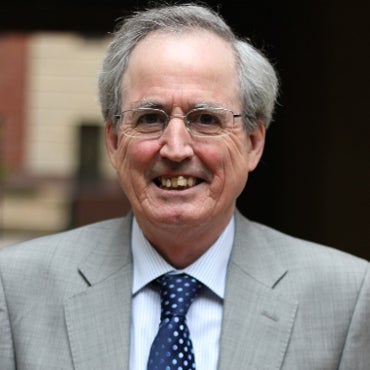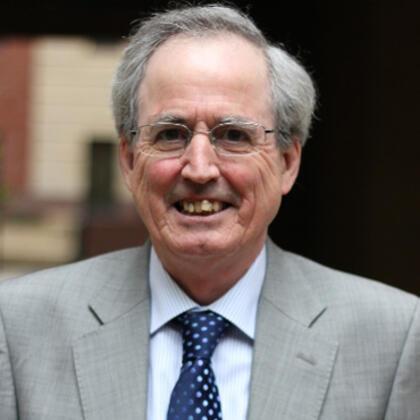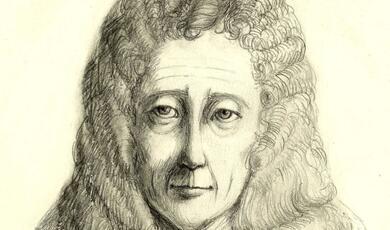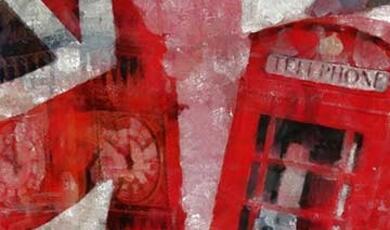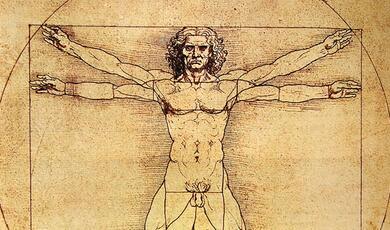Turing and von Neumann
Share
- Details
- Transcript
- Audio
- Downloads
- Extra Reading
Alan Turing (1912-1954) and John von Neumann (1903-1957) had an enormous range of interests not only in pure mathematics but also in practical applications. They made major contributions during the Second World War; Turing on cryptography and von Neumann on weapons development. The Turing machine formalised the idea of an algorithm and the Turing test is important in artificial intelligence while von Neumann founded the subject of game theory. Both are considered founders of computer science.
Download Transcript
19 April 2016
Turing and von Neumann
Professor Raymond Flood
Thank you for coming to my lecture today. I will be speaking about John von Neumann and Alan Turing.
Both of them had an enormous range of interests not only in pure mathematics but also in practical applications. They made major contributions during the Second World War: Turing on cryptography and von Neumann on weapons development. The Turing machine formalised the idea of an algorithm and the Turing test is important in artificial intelligence while von Neumann founded the subject of game theory. Both are considered founders of computer science.
John von Neumann was born in 1903 in Budapest. Budapest at the turn of the century produced many fine mathematicians and physicists but von Neumann’s brilliance stood out. He was a child prodigy learning several languages and showing early exceptional ability in, and enthusiasm for, mathematics. By age six he could divide two eight digit numbers in his head, by age eight he was studying the calculus and by age twelve he had read and understood Borel’s Theory of Functions. He also had an amazing memory and was supposed to be able to memorize at a glance the names, addresses and telephone numbers in a column in a telephone directory. He retained this ability of absolute recall all his life.
Von Neumann’s father was not keen on him becoming a mathematician for financial reasons and they compromised on a career in chemistry. He studied chemistry first of all in Berlin from 1921 to 1923 and then in Zurich for the next two years. Simultaneously he was registered to study mathematics in Budapest although he never attended any lectures there. Nevertheless, in 1926 he received a diploma in chemical engineering from Zurich and a doctorate in mathematics from Budapest!
Von Neumann was famous for his speed of thinking and there are many stories about his ability. One of my favourites is his solution of the famous fly puzzle.
The setup is as follows.Two cyclists start 20 miles apart and cycle towards each other at a constant speed of 10 miles per hour. At the same time a fly starts from the leftmost cyclist and flies towards the rightmost cyclist at 15 miles per hour.
On arrival the fly immediately turns around and flies back until it arrives at the left cyclist when it again turns around and flies to the right.
The fly continues to do this until the cyclists meet. The question is to calculate the total distance that the flies travels.
The slow way to find the answer is to calculate the distance travelled on the first rightwards leg of the fly’s journey then the next leftwards leg then the next rightwards leg etc., etc., and then sum the resulting infinite series of continually decreasing distances.
But the quick way is to notice that the cyclists meet exactly one hour after they start – they are approaching each other at twenty miles an hour and they are 20 miles apart - and the fly is travelling for all of that hour so the answer is 15 miles because the fly is travelling at 15mph!
When von Neumann was asked the puzzle he replied instantly with the right answer of 15 miles. The disappointed questioner said something like: “Oh, you’ve heard it before and know the trick?” Von Neumann replied “What trick – all I did was to sum the infinite series.”
Von Neumann’s doctoral thesis was entitled The Axiomatic Deduction of General Set Theory and was very influential and he kept an interest in set theory and logic for the rest of his life. Towards the end of the 1920s he had academic positions at Berlin and Hamburg.
Two of his main interests during this time were quantum mechanics and operator theory. His basic insight was that the geometry of the vectors in certain infinite dimensional spaces, called Hilbert spaces, has the same formal properties as the structure of the states of a quantum-mechanical system. Von Neumann’s book on Quantum Mechanics appeared in German in 1932 and has been widely translated. The Nobel physics prize winner Eugene Wigner said that Von Neuman’s contributions to quantum mechanics alone “would have secured him a distinguished position in present day theoretical physics.”
In 1928 he published a paper establishing the subject of game theory. Von Neumann’s work on games is characteristic of a lifelong approach of using mathematics in practical situations. The consequences of his work go far beyond its applications to games of chance, such as poker, and have been important in economics, psychology, sociology, politics and military strategy.
A zero-sum game between two players is one in which the gain to the winning player exactly equals the loss to the loser, so the total payoff to both players sums to zero. Essentially Von Neumann proved that zero-sum games are not worth playing, in the sense that each player can always find an optimal strategy! Let me explain.
He developed Game theory to cover conflicting situations where:
There may be any (finite) number of players
Each player can take one of a finite number of actions and different players can have a different list of actions they can take.
At each play of the game players do not know what action will be taken by the other players.
The result of the game determines a payment to each player which can be positive, zero or negative.
As I’ve mentioned if the sum of payments to all players is zero the game is called a zero-sum game and, of course, if there are also two players it is two person zero-sum game. A crucial concept in game theory is the payoff matrix.
Example:
YOU
Action aAction bAction gMEAction 13-5-2
Action 2698
Action 3-16-3
Here we have two players, You and Me. You can take one of three courses of action called a, b or g while I also have three courses of action 1, 2 or 3. The entries in the payoff matrix give the payment I receive corresponding to our choices of action.
So if I choose action 2 and you action g I will win £8 and because it is a zero-sum game you will lose £8, in other words you give me £8.
If I choose action 1 and you choose action b the corresponding entry in the payoff matrix is -£5 so you will win £5 and I will lose £5.
So how should each of us play this game with this payoff matrix? The underlying idea for each player’s choice of action is to get the best payoff in a worst case scenario. Another way of putting it is to get the best payoff when your opponent makes his or her best counter move. This is a risk-averse strategy. Let us see what it means for the payoff matrix in the example.
I look at the payoffs on taking action 1, over all the actions you could take, and I note the minimum payoff as -5. This is just saying that the minimum entry in the first row is -5 and is the worst that could happen if I take action 1.
Similarly for action 2 the minimum payoff is 6.
And for action 3 the minimum payoff is -3.
Now my risk averse strategy is to maximise my minimum payoff which is to take action 2 and obtain a payoff of at least 6.
Let us perform the analogous analysis for you. Remember the payoff matrix is written from my viewpoint. So for the entries written this way you want to minimise the maximum number appearing in each column.
So you look at the payoffs on taking action a, over all the actions I could take, and note the maximum entry 6 in the first column which is the worst that could happen to you.
If action b is taken the maximum value in the second column is 9 which is the worst that could happen on taking action b.
If action g is taken the maximum value in the third column is 8 which is the worst that could happen on taking action g.
The way to minimize the worst that could happen is to take action a.Using the risk-averse approach, I want to maximise the row minima and you want to minimise the column maxima. In this case for this game these two numbers coincide with action 2 for me and action a for you, giving a payoff of 6 to me.Such a combination of actions where the maximum of the row minima coincides with the minimum of the column maxima is called an equilibrium point for the game. It is called this because by taking these actions the players guarantee themselves a certain minimum payoff and neither player has a motivation to move from their equilibrium decision. Also, both players can announce their decided course of action in advance to their opponent secure in the knowledge that this information will not allow their opponent to get a better payoff.This type of equilibrium point is sometimes called a saddle point. This is because if we think of my actions as being points, x, along the X-axis and your actions as points, y, along the Y-axis and the payoff as a function z of the pair (x, y) then z can be thought of as giving a surface. I want to get the highest peak on the surface while you want to get the lowest valley on the surface. So if we have an equilibrium of this sort which is at the same time the highest point in the x direction and the lowest point in the y direction then it looks like the point S in this diagram which is usually called a saddle point. It is also called a minimax point. The payoff at this point is called the value of the game and here is 6.[1]
When a player always takes the same action it is called a pure strategy.
YOU
RockPaperScissorsMERock0-11
Paper10-1
Scissors-110
Rock beats (smashes) scissors:
Also each player can reveal their strategy without giving their opponent any advantage.
Von Neumann later said about this result:
Their 1944 book Theory of Games and Economic Behaviour revolutionised the field of economics.
This is an informal statement of Nash’s theorem;
Let me say a little about Turing’s life up to this point.
I have gone rather differently from the book because in this way it should seem less “magicky”
Is it consistent, that is, is mathematics free from contradiction?
Turing was intrigued by this problem in mathematical logic.
Any “algorithm” can be carried out by one of his machines
101
Read the symbol on the square under the head.Leave it unchanged or edit the symbol by writing another symbol.Move the tape left or right by one square so that the machine can read and edit the symbol on a neighbouring square.StateSymbol readWrite instructionMove instructionNext stateState 0BlankNoneMove the tape to the leftStop state
0Write 1Move the tape to the rightState 0
1Write 0Move the tape to the rightState 0
101
100
110
010
011
The idea of a Turing machine became the foundation of the theory of computation.
Turing wrote to his mother on arrival at Princeton that:
The mathematician Paul Halmos was a research assistant to von Neumann during the war and wrote:
There were 17,576 Rotor settings as each rotor could be inserted in any of 26 positions.
There were 6 ways to put the three rotors in the three positions.
The Plugboard connected seven pairs of letters and could be achieved in 1,305,093,289,500 ways
This gives the total number of keys or setups for the Enigma as
17,576 × 6 × 1,305,093,289,500
Hodge’s book is also an excellent biography of Turing. They both have associated websites: http://www.turing.org.uk/ and http://simonsingh.net/cryptography/ http://www.telegraph.co.uk/history/world-war-two/11151478/Could-you-have-been-a-codebreaker-at-Bletchley-Park.html
Simon’s book also contains the crossword set in the The Daily Telegraph by Bletchley Park to recruit codebreakers. They challenged readers to complete it in less than 12 minutes. Those who did so were invited to a further crossword test and it led to six new recruits. I’ve given a web reference to the crossword that was published in the Daily Telegraph.
Turing and his colleagues analysed the logical structure of Enigma. In particular they used the feature that if the Enigma, in any state, changed A into E then in the same state it would change E into A and this symmetry would hold for all encipherments in a given state. There was a practical advantage to this because it allowed the decipherment operation to be the same as the enciphering. But it was a considerable weakness. Let me indicate how.
A crib is when you know the plain language meaning of a piece of ciphertext. On the slide I show a crib.
Guessed plaintext: w e t t e r
is encrypted into
Known Ciphertext: E T J W P X
Now it was sometimes possible to find loops in cribs. There is a loop in this crib:
w goes to e. Then the rotor clicks round once and t goes to w and the rotor clicks round twice more when t goes back to e. Remember in a given state of the machine pairs of letters are swapped.
So now let us have three Enigma machines, the first one at the top in some state S the next one in the middle in state S +1 where the rotor has clicked round and the third at the bottom in state S + 3 where the rotor has clicked round twice more.
We are now going to parallel the loop in the crib by an electric circuit. We will connect the output of each Enigma to the input of the next. So e coming out of the first goes to input e of the second and output t of the second goes to input t of the third and finally output w of the third goes to input w of the first.
But this way of connecting the machine essentially cancels the effect of the plugboards and allowed Turing to ignore billions of plugboard settings. For example the current flowing out of the rotors of the first machine goes through the plugboard from some letter L1 to e but then in the second machine goes back from e to L1. These two plugboards cancel each other out and the same thing happens between the middle and bottom plugboards and the bottom and top plugboards. Turing does not know L1 but there are only 26 letters it could be. We could try a circuit for each of them or have 26 circuits each with a bulb.
I am skipping details but essentially all that needs to happen now is for the rotors of each machine to click round in unison until the circuit is complete and the light comes on! Many more details are in the books by Singh and Hodges.
Both Turing and von Neumann were recognised for their contributions to the war effort with Turing receiving an OBE and von Neumann the Presidential Medal of Freedom.
Apart from their other common interests they also had a shared interest in biology.
Turing had a lifelong interest in the development of pattern and form in living organisms. He looked at how biological systems that are symmetrical at the start can lose that symmetry, and wondered how this could be caused by the dynamics of the way that the chemicals diffuse and react. Using a computer, he carried out pioneering work in modelling these chemical reactions, and published his results in his 1952 paper, The Chemical Basis of Morphogenesis.
Underneath is an example of a 'dappled' pattern resulting from one of his systems.
Another major contribution Turing made was his paper on Computing Machinery and Intelligence in the journal Mind. Turing started:
I propose to consider the question, ‘Can machines think?’
He refined this question by introducing what he called The Imitation Game. In this game there is a machine, a woman and an interrogator.
The object of the game, called the Turing test, is for the interrogator to determine which of the others is the machine and which is the woman. They can communicate with the interrogator, but only in a manner that gives no clue to their identities. In his previous work with Turing machines, Turing concentrated on what machines cannot do. Now his focus was on what they can do, and in particular whether the behaviour of the brain can be replicated by a computer. The Turing test remains important in philosophy and artificial intelligence.
After the war was over, Turing went to the National Physical Laboratory in London to work on the design of an electronic computer, the Automatic Computing Engine (ACE). His final university position was as Deputy Director of the Manchester Computing Laboratory. Turing continued to be consulted by GCHQ, the successor to Bletchley Park, but lost his security clearance when he was brought to trial for homosexual activities in 1952. He came under intense scrutiny by the intelligence services, who regarded him as a security risk. He died of cyanide poisoning, aged 41, a half-eaten apple beside his bed, and the inquest brought in a verdict of suicide. Von Neumann also died young – in his case at the age of 53. He left unfinished his research program on a new information and computation theory for biological systems, especially the brain. Inspired, I think, by Turing’s universal machine he was developing his theory of self-reproduction of automata five years before the work of Watson and Crick on the structure of DNA and its role in biological self-reproduction.
Von Neumann and Turing made massive contributions to mathematics, computer science and the times in which they lived and their work continues to have an important impact on our world today.
Thank you for coming along and I hope you enjoy next year’s program of lectures.
© Professor Raymond Flood, 2016
[1] Source: John L. Casti, Five Golden Rules: Great Theories of 20th-Century Mathematics, Wiley 1996
This event was on Tue, 19 Apr 2016
Support Gresham
Gresham College has offered an outstanding education to the public free of charge for over 400 years. Today, Gresham plays an important role in fostering a love of learning and a greater understanding of ourselves and the world around us. Your donation will help to widen our reach and to broaden our audience, allowing more people to benefit from a high-quality education from some of the brightest minds.


 Login
Login
